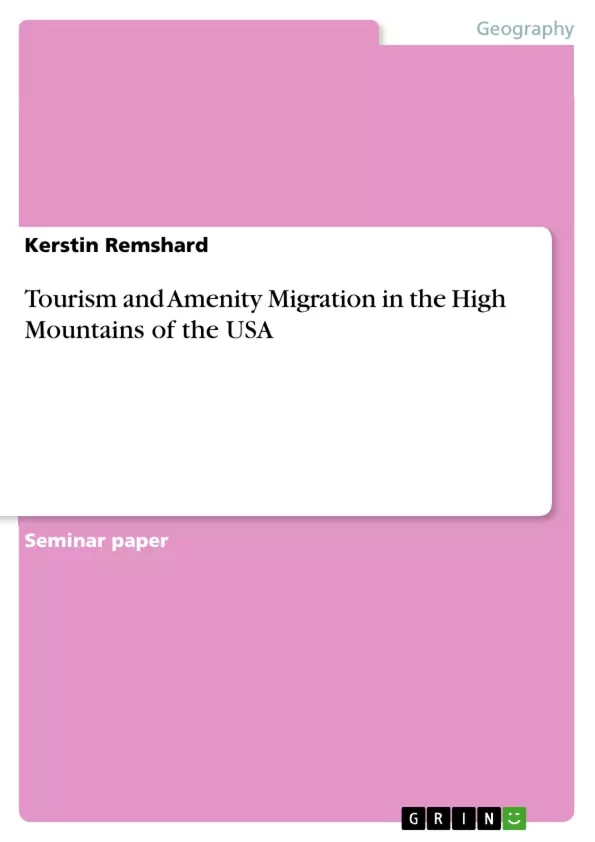In the nineteenth century visits to the mountains were limited because of a lack of access, poor roads, limited leisure time and low income of the majority of North American citizens (Goeldner, 1996). In the 1860s railroads were built and roads improved, so travel increased slowly, although it was still a privilege of people with high incomes. The number of travellers did a huge jump after World War I as the automobile became affordable for “middle class” families. As the infrastructure improved, more and more summer tourists arrived. A tourism-based economy began to grow, hotels, motels and restaurants were built. Until the skiing movement started in the 50’s and 60’s the winter season was long and uneventful (Goeldner, 1996). When skiing finally became a national trend, major ski resorts developed and many of them were and still are two-season resorts. Central to the tourist group from the mid 60’s on were the baby boomers, ranging in age from 18 to 35 (Goeldner, 1996). As the numbers of tourists were still rising in the 1980’s, locally owned establishments saw themselves competing with big-time operators. Usually a whole complex of lodging, restaurants and everything else to serve the tourists was developed. In the 1990’s mountain tourism has grown to be a powerful economic force. Fast food chains like McDonalds and accommodation chains such as Holiday Inn have come on the scene (Goeldner, 1996). Today in mountain communities outlet stores, gambling, country clubs, exclusive residences etc. can be found. Competition is tougher than ever before and environmental issues challenge the high mountain communities.
Inhaltsverzeichnis (Table of Contents)
- Tourism
- Historical development
- Types of High Mountain tourism
- Skiing tourism
- Finding sustainability in winter sports: Large or small?
- The Colorado ski industry
- Ski resort growth (Example: Whistler, British Columbia)
- The transformation of mining towns into tourist towns
- Gambling in the Rocky Mountains
- Ecological impact of unmanaged OHV-use
- Amenity migration
- Definition
- Characteristics of amenity migrants
- Reasons for increasing amenity migration
- Major impacts
Zielsetzung und Themenschwerpunkte (Objectives and Key Themes)
This text aims to explore the impact of tourism and amenity migration on the high mountain regions of North America. It examines the historical development and current state of the tourism industry in these areas, with a focus on skiing tourism and the transformation of mining towns into tourist towns. The text also explores the phenomenon of amenity migration, including its motivations, characteristics, and impacts.
- Historical development of tourism in the high mountains of North America
- The role of skiing in the tourism economy of North America
- The transformation of mining towns into tourist towns
- The motivations and characteristics of amenity migrants
- The impact of both tourism and amenity migration on high mountain communities
Zusammenfassung der Kapitel (Chapter Summaries)
The text begins with a discussion of the historical development of tourism in the high mountains of North America. It highlights the increasing accessibility of these regions, the growth of the tourism industry, and the development of major ski resorts.
The next chapter examines the various types of tourism in the high mountains, including cultural, heritage, health, ecotourism, and adventure sports. The chapter also discusses the increasing popularity of sports-oriented tourism and the potential negative environmental and societal impacts associated with it.
The following chapter delves into the specific topic of skiing tourism. It explores the sustainability of different models of ski resort operation, contrasting the small, co-operative model common in Europe with the large, consolidated model prevalent in North America. The chapter then examines the specific case of the Colorado ski industry, highlighting its growth and the need for developing non-skiing activities to attract visitors.
Schlüsselwörter (Keywords)
Key terms and concepts covered in this text include: high mountain tourism, amenity migration, skiing tourism, sustainability, ski resort development, mining towns, tourist towns, environmental impacts, and social conflicts.
- Citar trabajo
- Kerstin Remshard (Autor), 2005, Tourism and Amenity Migration in the High Mountains of the USA, Múnich, GRIN Verlag, https://www.grin.com/document/54855



